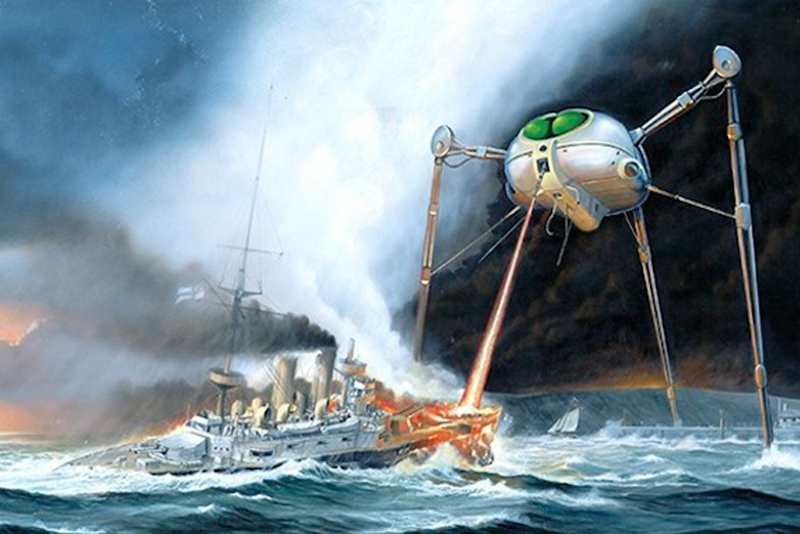
A UK consortium named Dragonfire is working towards initial laser demonstrations which will potentially culminate in a weaponised capability over the next ten years – but it won’t be Star Wars.
War of the Worlds
“The Martians fought with weapons as yet unimagined by the people of Earth; an invisible sword of fire that destroyed all it touched.”
The foresight exhibited by HG Wells when writing his book War of the Worlds in 1897, predated the first laser by over 60 years. It was not until 1960 that Theodore Maiman invented the world’s first laser, known as the ‘ruby laser’, as it produced a red visible light.

Fast forward another 60 years and now there is every probability that lasers will actually be used as weapons within the next decade.
Laser Guided Energy Weapons
One of the trials currently underway for laser guided energy weapons is the being conducted by the UK Dragonfire consortium. This is being let by MBDA with partners QinetiQ, Leonardo, Arke, BAE Systems and Marshall ADG.
Working on behalf of the UK Ministry of Defence who provided an investment of £30 million in January 2017, under contract to the Defence Science and Technology Laboratory (DSTL), the consortium’s stated objective is to develop a Laser Directed Energy Weapon (LDEW) through a limited Capability Demonstrator Programme (CDP).
In July 2019, then Defence Secretary Penny Mordaunt said that the Government would be investing around £130 million into Directed Energy Weapons research and demonstrations.
Speaking at a briefing at the Royal Aeronautical Society (RAeS) on 7 January, DSTL’s Ben Maddison said that the consortium had been making good progress over the last couple of years. “Much of the technology has come out of industry,” largely what was currently available. “It should also be cheap to fire and maintain, and it should hit the target straight away” he stated.
Challenges
Future systems need to be affordable, with little required maintenance and we cheap to use. “What we are looking for is something more effective than what we pay for in terms of current systems (such as missiles),” he added.
As a weapons system, lasers have a variety of component parts, from detection and tracking, though to the ‘human interface’, and power and cooling which must all work together. “If the laser can fire 100km, but the tracking only works out to one kilometre, then it is only effective at that range,” observed Maddison.
Potential uses include anti-UAV defence (potentially also including swarm attacks), as well as defending ships at sea from anti-ship missiles.

While lasers will work in fog and rain, there challenge will probably be more with the sensors used in detecting and tracking the target(s). There is also a question of legality when using lasers, particularly against people. But if the laser is attacking a manned platform, then the people onboard will suffer accordingly whether they are hit or not.
The Dragonfire consortium is working towards a position where it will have developed and demonstrated the capability of a laser weapon to a point where “in a few years time we will be to meet the UK’s military requirements, where down selecting and buying a laser weapon would be a sensible option,” stated Maddison.
There are three elements to that process. Can a laser weapon be actually built that would usefully deliver an effect. Secondly, what are the requirements for such a weapon. Finally, can it be effectively fielded onto a battlefield. The current demonstration will require three ISO containers; the laser module itself (to generate and direct the laser beam); the thermal management module to provide power generation and cooling; and a third to act as a command and control module.
Not Star Wars
“It isn’t going to be like Star Wars,”quipped Maddison. “The lasers cannot be seen when they operate and they won’t make much noise.”
Building a whole system requires ‘world leading subsystems and components’. The complexity means that subsystem testing and integration is happening simultaneously, so that results can be achieved over the terms of the development programme.
Laser beams can be powerful, both in terms of distance and when they are refracted off a target, so safety of operation is also a key item on the consortium’s worksheet.
“What we are hoping to achieve is to conduct a couple demonstrations culminating with a firing against a moving air target. Within the demonstration parameters, the consortium is not setting rigid goals “to blast things out of the sky,” but to determine and understand how to get a certain amount of laser power onto a target and be effective.
Essentially the requirement will be: “to track and engage the targets using a range of movement; gauge the radiance on the target; assess the effectiveness of the weapon; use around 50 kilowatts of power; engage multiple targets in a series (mindful of swarming attacks); address power and heat management issues; conduct command and control; and target deconfliction.”
The ongoing challenge will be to drive down size, weight and power so that, in time, a laser weapon may be mounted on a vehicle or ship and powered by the host platform itself.










